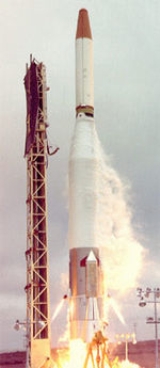
Atlas SLV-3
Encyclopedia
The Atlas SLV-3, or SLV-3 Atlas was an American
expendable launch system
derived from the SM-65 Atlas missile. It was a member of the Atlas
family of rockets, and was used for three suborbital
tests of X-23 Prime re-entry vehicle
s. Two orbit
al launches were also conducted, both of which failed.
The Atlas SLV-3 was a stage and a half rocket, built as a standardised replacement for earlier Atlas launch systems, which had been derived from the various Atlas missiles. A Burner
upper stage was flown on the final flight to increase payload.
It is most well known for launching the Augmented Target Docking Adapter (ATDA), a backup for the Gemini Agena Target Vehicle
which was to be used by Gemini 9
after its GATV failed to reach orbit. The launch was conducted on 1 June 1966, and was the first flight of the Atlas SLV-3 as an independent vehicle. It was only discovered after Gemini 9 had rendezvoused
with it that the launch had itself failed, as the payload fairing had not separated.
The Atlas SLV-3 was also used as the first stage of several Atlas-Agena
and Atlas-Centaur
variants.
United States
The United States of America is a federal constitutional republic comprising fifty states and a federal district...
expendable launch system
Expendable launch system
An expendable launch system is a launch system that uses an expendable launch vehicle to carry a payload into space. The vehicles used in expendable launch systems are designed to be used only once , and their components are not recovered for re-use after launch...
derived from the SM-65 Atlas missile. It was a member of the Atlas
Atlas (rocket family)
Atlas is a family of U.S. space launch vehicles. The original Atlas missile was designed in the late 1950s and produced by the Convair Division of General Dynamics, to be used as an intercontinental ballistic missile...
family of rockets, and was used for three suborbital
Sub-orbital spaceflight
A sub-orbital space flight is a spaceflight in which the spacecraft reaches space, but its trajectory intersects the atmosphere or surface of the gravitating body from which it was launched, so that it does not complete one orbital revolution....
tests of X-23 Prime re-entry vehicle
Atmospheric reentry
Atmospheric entry is the movement of human-made or natural objects as they enter the atmosphere of a celestial body from outer space—in the case of Earth from an altitude above the Kármán Line,...
s. Two orbit
Orbit
In physics, an orbit is the gravitationally curved path of an object around a point in space, for example the orbit of a planet around the center of a star system, such as the Solar System...
al launches were also conducted, both of which failed.
The Atlas SLV-3 was a stage and a half rocket, built as a standardised replacement for earlier Atlas launch systems, which had been derived from the various Atlas missiles. A Burner
Burner (rocket stage)
The Burner and Burner 2 rocket stages have been used as upper stages of launch vehicles such as the Thor-Burner and Delta since 1965. The currently available Burner 2 is powered by a Star 37 solid rocket motor....
upper stage was flown on the final flight to increase payload.
It is most well known for launching the Augmented Target Docking Adapter (ATDA), a backup for the Gemini Agena Target Vehicle
Agena Target Vehicle
The Agena Target Vehicle was an unmanned spacecraft used by NASA during its Gemini program to develop and practice orbital space rendezvous and docking techniques and to perform large orbital changes, in preparation for the Apollo program lunar missions.-Operations:Each ATV consisted of an Agena-D...
which was to be used by Gemini 9
Gemini 9A
- Backup crew :- Original primary crew :- Mission parameters :* Mass: * Perigee: * Apogee: * Inclination: 28.91°* Period: 88.78 min- 1st rendezvous :* June 3, 1966 - 17:45 - 18:00 UTC- Spacewalk :* Cernan...
after its GATV failed to reach orbit. The launch was conducted on 1 June 1966, and was the first flight of the Atlas SLV-3 as an independent vehicle. It was only discovered after Gemini 9 had rendezvoused
Space rendezvous
A space rendezvous is an orbital maneuver during which two spacecraft, one of which is often a space station, arrive at the same orbit and approach to a very close distance . Rendezvous requires a precise match of the orbital velocities of the two spacecraft, allowing them to remain at a constant...
with it that the launch had itself failed, as the payload fairing had not separated.
The Atlas SLV-3 was also used as the first stage of several Atlas-Agena
Atlas-Agena
The Atlas-Agena was an American expendable launch system derived from the SM-65 Atlas missile. It was a member of the Atlas family of rockets, and was used for 119 orbital launches between 1960 and 1978....
and Atlas-Centaur
Atlas-Centaur
The Atlas-Centaur was an American expendable launch system designed and built by General Dynamics Convair Division in San Diego, CA. It was derived from the SM-65 Atlas missile. It was a member of the Atlas family of rockets, and was used for 61 orbital launches between 1962 and 1983. It was...
variants.

